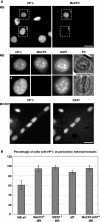MeCP2 interacts with HP1 and modulates its heterochromatin association during myogenic differentiation
- PMID: 17698499
- PMCID: PMC2018631
- DOI: 10.1093/nar/gkm599
MeCP2 interacts with HP1 and modulates its heterochromatin association during myogenic differentiation
Abstract
There is increasing evidence of crosstalk between epigenetic modifications such as histone and DNA methylation, recognized by HP1 and methyl CpG-binding proteins, respectively. We have previously shown that the level of methyl CpG-binding proteins increased dramatically during myogenesis leading to large-scale heterochromatin reorganization. In this work, we show that the level of HP1 isoforms did not change significantly throughout myogenic differentiation but their localization did. In particular, HP1gamma relocalization to heterochromatin correlated with MeCP2 presence. Using co-immunoprecipitation assays, we found that these heterochromatic factors interact in vivo via the chromo shadow domain of HP1 and the first 55 amino acids of MeCP2. We propose that this dynamic interaction of HP1 and MeCP2 increases their concentration at heterochromatin linking two major gene silencing pathways to stabilize transcriptional repression during differentiation.
Figures




References
-
- Nan X, Ng HH, Johnson CA, Laherty CD, Turner BM, Eisenman RN, Bird A. Transcriptional repression by the methyl-CpG-binding protein MeCP2 involves a histone deacetylase complex. Nature. 1998;393:386–389. - PubMed
-
- Eissenberg JC, Elgin SC. The HP1 protein family: getting a grip on chromatin. Curr. Opin. Genet. Dev. 2000;10:204–210. - PubMed
-
- Bannister AJ, Zegerman P, Partridge JF, Miska EA, Thomas JO, Allshire RC, Kouzarides T. Selective recognition of methylated lysine 9 on histone H3 by the HP1 chromo domain. Nature. 2001;410:120–124. - PubMed
Publication types
MeSH terms
Substances
LinkOut - more resources
Full Text Sources
Molecular Biology Databases
Miscellaneous

